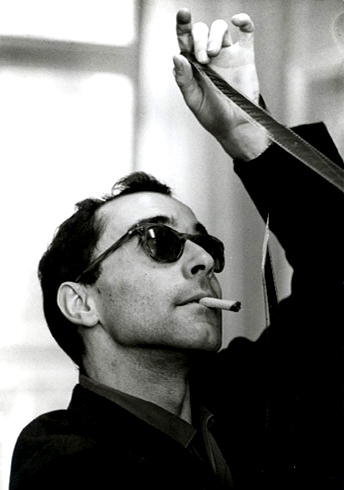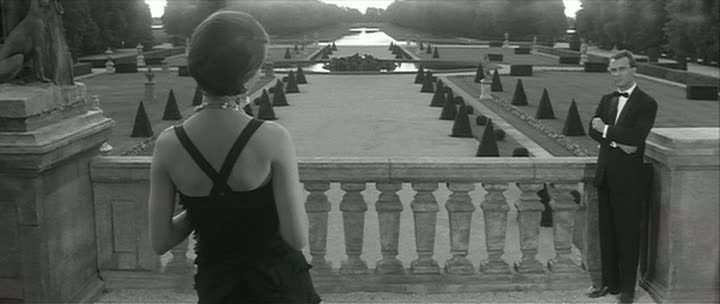

{Godard, Source} {Truffaut, Source}
For instance they often use tracking shots that are way too long and make an audience uncomfortable or using a freeze frame at the end of the film so that all movement ceases and often the main character captured in a defining moment (of course now this technique is often used in a rather banal manner making it rather cliche). This was first used in The 400 Blows as a means to trap the main character and reflect on how he is caged and has nowhere left to go, thus using a cinematic technique to comment directly on a character. Godard used jump cuts (when a piece of the action is missing from a continuous shot making the image appear to jerk or jump) as a way to shorten his film, but it was also a means to constantly remind viewers that they were watching a film and had not been carried away to some other world. They are not a fly on someones wall, but instead a patron sitting in a theater.
The French New Wave is such a wonderful and influential period of filmmaking and I can only begin to touch on it here. Even though now many of the techniques that they used in their films can be considered somewhat mainstream, the thought behind the technique has often been lost. When you go back and watch these films you can see what they were trying to accomplish more clearly. At times it can be uncomfortable to watch (not violent or sexual, but more 'what in the world is going on?'), but stick with the films and you will be rewarded.
{source}
Now onto Last Year at Marienbad. Resnais is considered to be in a subset of the French New Wave often referred to as the Left Bank. These filmmakers, which also includes Chris Marker (La Jetee) and Agnes Varda (Cleo From 5 to 7), were the more artsy fringe of the movement. Though the French New Wave as a whole was interested in challenging tradition in cinema the left bank really pushed the envelope. While Godard and Truffaut were film critics taking the leap into filmmaking somewhat as a way to test their theories, the Left Bank contingency was made up more of artists. Their films sometimes even veered into experimental filmmaking.
To use a contemporary comparison trying to make sense of the plot or structure of Last Year at Marienbad is like trying to make sense of the television series Lost; when it comes down to it structural clarity is not necessarily the point. And believe me Lost is a cakewalk compared to Marienbad. Resnais is particularly interested in memory and his most famous films (Night and Fog, Hiroshima Mon Amour, Marienbad) explore the manner in which we store our most heinous memories be they personal or collective. For instance Night and Fog tackles The Holocaust and if land can maintain memory. Resnais brings his camera to concentration camps a decade after they were liberated and juxtaposes the modern footage with archival footage of the camps, thus taking leaps from the present to the past and back again. I first watched this film in 8th grade and the images, the sound of the narrator, were burned into my own memory. The two images that stayed with me most vibrantly was one of bodies being bulldozed (a painful image, but necessary) and one of the modern grown over fence cutting through a green landscape.
{source}
Last Year at Marienbad looks at tragedy on a more personal level. The main character is trying to either rationalize his role in a rape and possible murder or his complicity in the murder of a woman with which he was/is in love. Depending on your interpretation perhaps there was not even a murder, perhaps the woman escaped with the love of her life at her side. Perhaps everyone is dead, portrayed only as a memory. Often Resnais jumps from one location to another, one moment in time to another during what appears to be one simultaneous conversation/thought. So the past and the present become blurred.It is easy to write off Marienbad as weird and unfocused because it demands so much from its viewers. This is not an easy, popcorn film. All of the characters walk through the film in a daze, with little emotion to guide the viewer. Plot points and characters, who are never even named, are vague and barely developed. When watching the film you shouldn't try to make sense of it all, but experience it. Whatever you think is happening, is happening in some way, allow your mind to fill in the spaces. There is not a right or wrong in this film.
This may be a hard film to watch, but it will stay with you as you ponder what it all means. You will benefit from multiple viewings, don't be scared to watch it twice. Sometimes when I watch films like this I get put into this dreamy, half asleep state that allows me to follow the film even better (and sometimes I fall asleep). If you have never watched a French New Wave film (or an experimental film) before I would advise watching some of the more accessible ones first before Last Year at Marienbad.
If you give the film a chance you can really begin to think about memory and how we alter it to fit our perceptions of ourselves, our lives. Often if our memories were exact interpretations of what really happened perhaps we would not be able to exist in the world. Our actions would be to hard for us to bear.



2 comments:
I only recently saw this and I'm a big fan of french new wave. I feel like this is one of those films that shouldn't be classified as new wave because it can be misleading and it doesn't fit in with some of the original intentions of new wave. It made me think of some of Luis Brunuel's early films--not exactly my taste, but the cinematography was stunning. A little too Sartresque for me but maybe a second viewing would be different.
I would have to say that Resnais is one of the more important filmmakers (next to Truffaut and Godard of course) of the New Wave, particularly the Left Bank. The production itself follows many elements of the movement: small camera, location shooting, non-continuous editing. There is almost too much narrative element for me to really compare Marienbad with Bunuel. I think Resnais is challenging traditional cinema without abandoning it whereas Bunel is giving us something entirely new (thus the cutting of the eye at the beginning of Un Chien Andalou).
Post a Comment